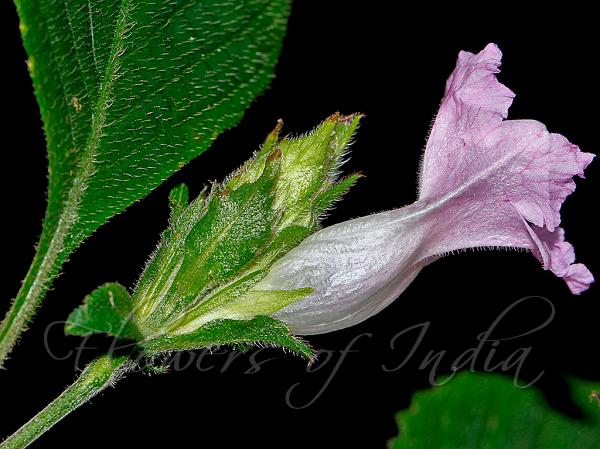|
| Rough Coneflower |
|

|

| File size | 262485 |
| Original date | 11/25/17 11:18 AM |
| Resolution | 1024 x 768 |
| Flash | Flash fired |
| Focal length | 100.0mm |
| Exposure time | 1/200s |
| Aperture | 11.0 |
| Focus Distance | |
| Metering Mode | Center weighted average |
| Camera make | Canon |
| Camera model | Canon EOS 7D |
| Sensor type |
|
|
|
|
Photo: |
Botanical name: Strobilanthes neoasper Family: Acanthaceae (Acanthus family)
Synonyms: Nilgirianthus asper, Strobilanthes aspera, Strobilanthes asper Wight
Synonyms: Nilgirianthus asper, Strobilanthes aspera, Strobilanthes asper Wight
Rough Coneflower is a shrub, up to 1 m tall, with
stems quadrangular, grooved on two faces, hairy, hairless when old.
Leaves are opposite, about 12 x 7 cm, variable, mostly elliptic-ovate,
wedge-shaped and decurrent at base, rounded toothed-crenulate at
margin, tapering at tip, membranous, hairy, lineolate on both surfaces;
lateral nerves 7-10 pairs; leaf-stalks about 5 cm long. Flowers are
borne in panicles with compact spikes; spikes ovate, 2.5-5 cm long in
flower, 5-8 cm long in fruit. Flower-cluster-stalks are
glandular-hairy; bracts elliptic-ovate or elliptic-lanceshaped, about
1.3 cm long, glandular-hairy; bracteoles linear, blunt or pointed,
about 1 cm long, fringed with hairs, glandular-hairy. Calyx is about 1
cm long, lobed almost to base; tube about 1 mm long; lobes 5,
linear-lanceshaped, equal, densely glandular-hairy in upper half,
thinly so or hairless in the lower. Flowers are tubular-swollen, about
1.5 cm long, pale lilac; cylinder base shorter, about 3 mm long; limb
bell-shaped, swollen, about 1.2 cm long, hairy, 5-lobed; lobes
triangular, blunt. Stamens are 4, not protruding, didynamous; staminal
sheath extending to 1/3 of bell-shaped portion, notched. Capsules are
elliptic, about 1 cm long, pointed at tip; seeds 4, round-obovate,
about 3 mm across. Rough Coneflower is endemic to Western
Ghats.
| Identification credit: P.S. Sivaprasad | Photographed in Eravikulam National Park, Munnar, Kerala. |
• Is this flower misidentified? If yes,